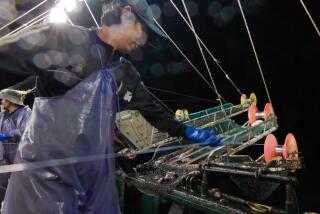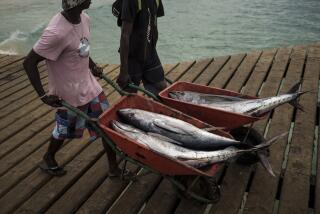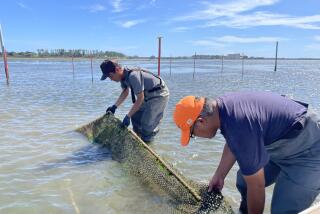U.S. fishing fleet pursues pollock in troubled waters
- Share via
DUTCH HARBOR, ALASKA — America’s biggest catch lands here and at nearby ports every year: more than 2 billion pounds of Alaskan pollock to feed a global appetite for fish sticks, fast-food sandwiches and imitation crabmeat.
The tightly managed Alaskan pollock fishery has been a rare success story in the U.S., which has seen the collapse of species such as New England cod and now imports 80% of its seafood.
Yet the careful management that helped make Alaskan pollock a billion-dollar industry could unravel as the planet warms. Pollock and other fish in the Bering Sea are moving to higher latitudes as winter ice retreats and water temperatures rise.
Alaskan pollock are becoming Russian pollock, swimming across an international boundary in search of food and setting off what could become a geopolitical dispute.
Andrew Rosenberg, former deputy director of the National Marine Fisheries Service, expects the pollock to be a test case in an emerging pattern of fish driven by climate change across jurisdictional boundaries.
“It will be a food security issue and has an enormous potential for political upheaval,” said Rosenberg, now a professor at the University of New Hampshire. “We aren’t getting along that well with the Russians now.”
A warming trend in the Bering Sea has forced fishermen like Jim Summers to motor 360 miles in his 191-foot trawler, the Aurora, to reach profitable fishing grounds. Docked here recently, he gingerly worked a hydraulic lever, unleashing 30,000 pounds of the mottled, pale-bellied pollock onto the deck.
“It feels like every year we’re going farther and farther north,” Summers said. “It used to be that most of our trips found fish near Dutch Harbor, with an occasional run up toward Russia. Now it has flipped.”
While Summers repositioned the net, a pair of 12-inch-diameter hoses vacuumed more than 1 million pounds of fish from the hold of the ship into a dockside processing plant. Once there, the fish coursed through a labyrinth of tanks, conveyor belts, and automated slicing, dicing and washing machines that turned the fish into fillets or fish paste.
This flow of white flesh was then frozen in blocks and stacked in containers on freighters, destined to be breaded and fried at McDonald’s and other fast-food restaurants, or shipped to Europe for fish-and-chips platters or to Japan for surimi, the fake crab at the heart of California rolls in sushi bars.
At a fueling dock nearby, Steve Olsen, captain of a stern trawler, pored over the GPS tracks of his trawls in recent years. The lines on the screen moved ever closer to Russian waters. “When you are towing [the net] and you stop finding fish, you typically turn northwest and you’ll find them again,” Olsen said.
His finger traced the squiggling line of a successful trawl that took his 112-foot ship, the Western Dawn, next to the border. “We could see the Russian guys fishing the other side,” he said. “We see them right on the line. If we see them right on the line, we’ll check it too.”
Pollock spawn each winter near the Aleutian Islands and then follow their food north as waters warm in the spring. But the food has shifted farther north with receding sea ice, and now pollock, which follow the northwesterly contour of the continental shelf, are shifting their range ever closer to Russian waters.
Scientists who help manage the fishery are confirming what fishermen report: The fish disappear from the Aleutians area each summer and can mostly be found near Russia.
Every June and July, federal scientists trawl a grid pattern in the Bering Sea in an area about the size of California. Counting the fish caught in these trawls and matching them against sonar readings, they estimate the size of fish stocks. These assessments help set limits on the next year’s catch to safeguard spawning stock.
An analysis of 25 years of surveys showed that the ranges of most fish are shifting north as the ice and cool water have retreated, said Franz J. Mueter, a fisheries oceanographer at the University of Alaska.
“What we found confirmed the obvious,” Mueter said. “As waters warm, a lot of fish on the eastern Bering Sea shelf are moving north.”
Not all scientists agree. Some suggest that other factors need further study, including different migration patterns of older and younger fish, whether trawl data provide a complete picture of fish populations, and whether these waters are becoming overfished despite the Marine Stewardship Council’s eco-label certifying that the pollock fishery is managed sustainably.
Federal scientists pointed out last week that their sampling showed the Bering waters were colder the last three summers. And yet pollock continue to appear mostly at the northwestern edge of their range.
Mueter’s study, published in the journal Ecological Applications, jibes with phenomena other scientists are finding in the Arctic, a region warming twice as fast as the rest of the globe. Their studies have chronicled bizarre subarctic blooms of tiny phytoplankton; massive seabird die-offs; and skinny, malnourished gray whales migrating deep into Arctic waters in search of food.
In the Northern Hemisphere, the range of fish appears to be shifting toward the North Pole two or three times faster than the range of animals on land, studies show.
Salmon have begun to colonize new rivers on Alaska’s north coast. The ranges of squid, mackerel and other baitfish are moving poleward, in some cases devastating nesting colonies of seabirds that depend on nearby fish to feed their young.
Some nations may gain a fishery while others will lose one. Norway may benefit from fish in the Atlantic moving away from more southerly waters controlled by Britain and other European nations. Fisheries experts wonder whether such shifts will spark another round of fighting akin to the Icelandic cod wars of the 1950s and 1970s, when fishermen rammed boats, cut nets and exchanged gunfire.
The potential for conflict could be realized in the Bering Sea, which is nicknamed America’s fish basket because more than half of all U.S. fish and shellfish are pulled from these waters. Together the U.S. and Russian pollock catches make up the largest human-food fishery in the world.
Already, suspicions are mounting. Russia this summer announced that its pollock catch was up and its stocks were in “good shape,” justifying a higher catch in 2009. Meanwhile, U.S. fisheries managers have scaled back on the catch in recent years. This summer’s survey, released Oct. 8, showed a drop in pollock stocks, prompting calls for further cutbacks.
Russia has allowed U.S. scientists to extend their annual surveys across the border only occasionally, resulting in uncertainty about how many Alaskan pollock are now in Russian waters.
“We think, depending on the year and conditions, that roughly 10 to 20% of the stock goes over to the Russian side,” said James N. Ianelli, a National Marine Fisheries Service scientist in charge of the annual assessment. An independent review suggested the spillover might be as high as 30%.
U.S. scientists can’t be sure how many fish the Russians are catching. They worry about lax enforcement and poaching, given reports of Russian mafia involvement in the fish trade.
Russian officials have been less than reassuring, said Keith Criddle, a marine policy professor at the University of Alaska.
Criddle was shocked at a Russian response when he suggested conducting an academic study of this shared fishery and applying game theory to determine whether the two nations should collaborate or compete.
“This deputy director first said, ‘Well, we’ve never fished up there,’ which is patently untrue,” Criddle said. Then the Moscow official launched into a lecture about climate change and oceanic conditions, and flatly rejected any notion that the Russian catch could affect the health of the fishery.
“It was weird, weird,” Criddle said. “Did I wander into the Twilight Zone or stick my foot into a sensitive international issue?”
If Russians take 20% of the catch, he asked, “do we eat it and reduce our catches to manage conservatively? If we get to the position where Russians are taking 50% of the catch, what are we going to do?”
Such questions are more than academic among fishermen who have been chasing these fish across the Bering Sea in recent years. Some question the restraint that fed their families and much of the world.
“I’ve heard this time and again,” said Summers, the captain of the Aurora. “ ‘If we don’t catch them, then the Russians are going to catch them.’ ”
--
More to Read
Sign up for Essential California
The most important California stories and recommendations in your inbox every morning.
You may occasionally receive promotional content from the Los Angeles Times.













